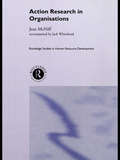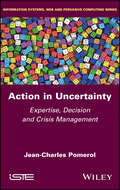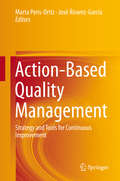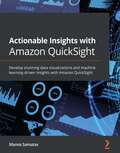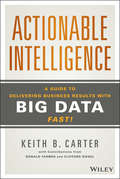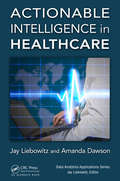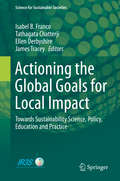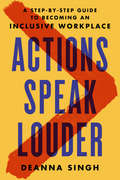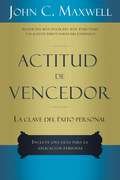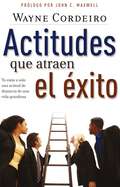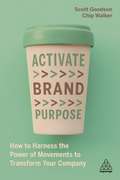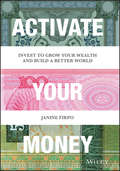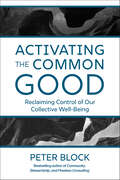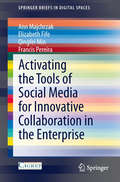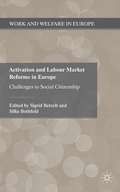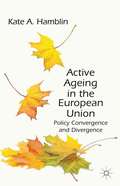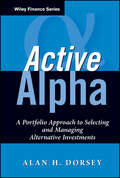- Table View
- List View
Action Research in Action: Thinking and Using Soft Systems Methodology Between Reality and Actuality (Translational Systems Sciences #46)
by Kenichi UchiyamaThis is the first book to provide the fundamental backbone for the field of action research (AR). One of the main characteristics of AR is to achieve a kind of learning based on experience through action in the real world, connecting and reconciling theory and practice by reflection for / in / by action. A standard form of AR has not yet been found, however, because it is difficult for conventional academicians to effectively bridge the gap between objectivity in theory and subjectivity in practice. For the past 50 years, soft systems methodology (SSM) has developed the methodology to deal with subjectivity by rigorously adhering to a coherent guideline of a systemic means for discussion— for example, accommodation (i.e., living with different individual worldviews). The author began to reinterpret SSM from an Eastern context at Lancaster University (UK), and received a Ph.D. at the London School of Economics, introducing the &“actuality&” point of view. This idea originated with the eminent Japanese psychiatrist Bin Kimura, who argued that schizophrenics do not lose touch with reality but with actuality. That is, there are two aspects of the world, reality and actuality, based on Latin res (&“thing&”) and actio (&“action&”). They can recognize all things of the world as &“reality&” as expressed by that noun but cannot comprehend with a feeling of reality the predicate &“actuality&”. Introducing actuality into SSM as a new dimension opened a new perspective in SSM both theoretically and practically. This topic is discussed in detail in Part II of this book. Part I contains three chapters. Chapter 1 provides a basic conceptual overview of SSM. Chapter 2 provides an actual trace of the evolution of SSM over the last 25 years. One topic that is expected to become the subject of serious practical application of SSM in the future is its application to resilience. This is discussed in some detail in Chapter 3. The actuality aspect of SSM has been used for more than 20 years in various contexts, yielding many good results. Among those are a new explanation of accommodation using paleo logic or predicate logic; a new management cycle based on actuality, such as learning for / in / by action; and the novelty of the methodological tool itself. Those 20 years of learning authenticate the guideline for the way of discussion or agreement that is relevant to actuality. Especially in the recent Covid-19 pandemic, it has oriented the restoration of actuality in the digital-based society, where actuality is deadened. This result is also dealt with in Part I.
Action Research in Organisations (Routledge Studies in Human Resource Development)
by Jack Whitehead Jean McNiffThe current orthodoxy is that 'knowledge' is the most powerful resource for organisational success. So how can managers develop the appropriate knowledge base to make their organisations grow? The answer lies in action research. Action research is increasingly perceived and used as a powerful methodology to promote professional awareness and development. However, there are very few texts that demonstrate how this can be utilised to promote management and organisational improvement or that emphasise the reflective nature of improving professionalism. Action Research in Organisations fills this gap. Aimed at both practising managers and university students alike, key features of this title include:* the location of management and organisational theory within a framework * examination of the principles and practice of action research* real-world examples and case studies of people attempting to improve their own situations through action research.
Action and Choice: An Introduction to Economics (Springer Texts in Business and Economics)
by Walter E. Block Ivan JankovicThis textbook is based upon a philosophical method of logical deduction from basic principles such as scarcity, individual choice and subjectivism. This textbook attempts to show that all complex phenomena of economic theory such as prices of consumer goods and factors of production, saving and consumption, interest and profit, can be explained by the same primitive psychological principles of scarcity and substitution on the margin that could be used to describe economizing Robinson Crusoe on a desert island or two cavemen catching fish or exchanging apples for oranges. This textbook distils the essence of economic science prevailing in price theory before the 1930s, which the authors’ argue is superior to currently popular mainstream theory into a readable and student-friendly textbook format.This is an introductory textbook written in the tradition of Menger, Bohm-Bawerk, Mises and Hayek, instead in the tradition of Alfred Marshall and John Maynard Keynes, as almost all modern textbooks are. The authors offer a text not predicated on physics envy; on an attempt to liken economics to the physical sciences, on the basis of “empirical evidence”, statistics and verification.
Action in Uncertainty: Expertise, Decision and Crisis Management
by Jean-Charles PomerolDespite uncertainty, people are born to act. Faced with environmental aggression and upheaval, inaction is more stressful than action. What choices, strategies or methods need to be implemented so that action is as effective as possible in terms of the objectives to be achieved? We should not delude ourselves about the term "good decision", which does not have much meaning when we act in an uncertain environment and when we know the weakness of forecasts. However, we must know how to act and be capable of taking the most appropriate action. Action in Uncertainty is a real guide to taking effective action when nothing is certain. According to the different types of uncertainty, what are the respective good uses of expertise and intuition? How do we motivate teams and avoid cognitive bias and manipulation? These themes are dealt with in clear and accessible terms to help decision-makers make the right choices in a world that is more uncertain than ever.
Action-Based Quality Management: Strategy and Tools for Continuous Improvement
by Marta Peris-Ortiz José Álvarez-GarcíaFeaturing case studies from the industrial and tourism sectors, this book provides an interdisciplinary perspective on the effect of total quality management on business and innovation strategies. The principles of Total Quality Management (TQM) have been widely researched and analyzed as an essential tool for businesses to compete in a globalized economy. This book presents the latest research on the applications of TQM across different functions such as customer service, human resources management and cost control. It demonstrates how the utilization of TQM tools, such as the SERVQUAL model, Eco-Management and Audit Scheme (EMAS), High Involvement Practices (HIWP) and the EFQM excellence model, impacts a firm's performance, enhances productivity and innovation and reduces cost, thereby allowing them to compete more effectively in the global market. Building on the extensive literature on the relationship between TQM and business performance, the authors argue that quality acts as a powerful competitive tool that companies should embrace in their corporate strategy. By promoting activities that result in greater efficiency, improved control and management of the organization (internal quality), firms can achieve significant improvement in customer satisfaction, employee satisfaction, social impact and business results (external quality) and exceed expectations in these areas.
ActionAid International: Globalizing Governance, Localizing Accountability
by Alnoor Ebrahim Rachel GordonAs a global NGO working in 45 countries, ActionAid International aims to eradicate poverty by addressing its underlying causes such as injustice and inequality. This case follows a series of radical transformations implemented by the organization's CEO, Ramesh Singh--a power shift from its headquarters in London to an international secretariat in Johannesburg; a new federated governance structure that increases the influence of units in Africa and Asia; and, innovations in accountability and transparency to the poor communities with which it works. But as Singh gets ready to step down after seven years, he is confronted with challenges from newly empowered country units that he feels risk taking the organization in the wrong direction. How will the divisions between the Northern and Southern units play out? Will they tear the organization apart, just when it is becoming a global player?
Actionable Insights with Amazon QuickSight: Develop stunning data visualizations and machine learning-driven insights with Amazon QuickSight
by Manos SamatasBuild interactive dashboards and storytelling reports at scale with the cloud-native BI tool - Amazon QuickSight, including embedded analytics and ML-powered insightsKey FeaturesUnderstand how to set up Amazon QuickSight, manage data sources, and build and share dashboardsLearn the advanced features of Amazon Quicksight to develop interactive and embedded dashboardsManage and monitor dashboards using the QuickSight API and other AWS services such as Amazon CloudTrailBook DescriptionThe adoption of cloud-native BI tools, like Amazon QuickSight, enables organizations to gather insights from data at scale. This book is a practical guide to performing simple-to-advanced tasks with Amazon QuickSight.You'll begin by learning QuickSight's fundamental concepts and how to configure data sources. Next, you'll be introduced to the main analysis-building functionality of QuickSight to develop visuals and dashboards. The book will also demonstrate how to develop and share interactive dashboards with parameters and on-screen controls. Advanced filtering options with URL actions will then be covered, before learning how to set up alerts and scheduled reports. Later, you'll explore the Insights visual type in QuickSight using both existing insights and by building custom insights. Further chapters will show you how to add machine learning insights such as forecasting capabilities, analyzing time series data, adding narratives, and outlier detection to your dashboards. You'll also explore patterns to automate operations and look closer into the API actions that allow us to control settings. Finally, you'll learn advanced topics such as embedded dashboards and multitenancy.By the end of this book, you'll be well-versed with QuickSight's BI and analytics functionalities that will help you create BI apps with ML capabilities.What you will learnUnderstand the wider AWS analytics ecosystem and how QuickSight fits within itSet up and configure data sources with Amazon QuickSightInclude custom controls and add interactivity to your BI application using parametersAdd ML insights such as forecasting, anomaly detection, and narrativesExplore patterns to automate operations using QuickSight APIsCreate interactive dashboards and storytelling with Amazon QuickSightDesign an embedded multi-tenant analytics architectureFocus on data permissions and how to manage Amazon QuickSight operationsWho this book is forThis book is for business intelligence (BI) developers and data analysts who are looking to create interactive dashboards using data from Lake House on AWS with Amazon QuickSight. This book will also be useful for anyone who wants to learn Amazon QuickSight in depth using practical examples. You will need to be familiar with general data visualization concepts, however, no prior experience with Amazon QuickSight is required.
Actionable Intelligence
by Keith B. Carter Clifford Siegel Donald FarmerBuilding an analysis ecosystem for a smarter approach tointelligence Keith Carter's Actionable Intelligence: A Guide to DeliveringBusiness Results with Big Data Fast! is the comprehensive guideto achieving the dream that business intelligence practitionershave been chasing since the concept itself came into being. Writtenby an IT visionary with extensive global supply chain experienceand insight, this book describes what happens when team membershave accurate, reliable, usable, and timely information at theirfingertips. With a focus on leveraging big data, the book providesexpert guidance on developing an analytical ecosystem toeffectively manage, use the internal and external information todeliver business results.This book is written by an author who's been in the trenches forpeople who are in the trenches. It's for practitioners in the realworld, who know delivering results is easier said than done -fraught with failure, and difficult politics. A landscape wherereason and passion are needed to make a real difference.This book lays out the appropriate way to establish a culture offact-based decision making, innovation, forward lookingmeasurements, and appropriate high-speed governance. Readers willenable their organization to:Answer strategic questions fasterReduce data acquisition time and increase analysis time toimprove outcomesShift the focus to positive results rather than pastfailuresExpand opportunities by more effectively and thoughtfullyleveraging informationBig data makes big promises, but it cannot deliver without theright recipe of people, processes and technology in place. It'sabout choosing the right people, giving them the right tools, andtaking a thoughtful--rather than formulaic--approach.Actionable Intelligence provides expert guidance towardenvisioning, budgeting, implementing, and delivering realbenefits.
Actionable Intelligence in Healthcare (Data Analytics Applications)
by Amanda Dawson Jay LiebowitzThis book shows healthcare professionals how to turn data points into meaningful knowledge upon which they can take effective action. Actionable intelligence can take many forms, from informing health policymakers on effective strategies for the population to providing direct and predictive insights on patients to healthcare providers so they can achieve positive outcomes. It can assist those performing clinical research where relevant statistical methods are applied to both identify the efficacy of treatments and improve clinical trial design. It also benefits healthcare data standards groups through which pertinent data governance policies are implemented to ensure quality data are obtained, measured, and evaluated for the benefit of all involved. Although the obvious constant thread among all of these important healthcare use cases of actionable intelligence is the data at hand, such data in and of itself merely represents one element of the full structure of healthcare data analytics. This book examines the structure for turning data into actionable knowledge and discusses: The importance of establishing research questions Data collection policies and data governance Principle-centered data analytics to transform data into information Understanding the "why" of classified causes and effects Narratives and visualizations to inform all interested parties Actionable Intelligence in Healthcare is an important examination of how proper healthcare-related questions should be formulated, how relevant data must be transformed to associated information, and how the processing of information relates to knowledge. It indicates to clinicians and researchers why this relative knowledge is meaningful and how best to apply such newfound understanding for the betterment of all.
Actioning the Global Goals for Local Impact: Towards Sustainability Science, Policy, Education and Practice (Science for Sustainable Societies)
by Isabel B. Franco Tathagata Chatterji Ellen Derbyshire James TraceyThis book highlights the value of sustainability science in newly emerging and innovative approaches to research, education, capacity building and practice in order to transform rhetoric into impact sustainability. Presenting case studies from various industries, sectors and geographical contexts targeting the seventeen (Sustainable development Goals (SDGs) outlined in the 2030 Agenda, it provides insightful recommendations to create sustainable impact while at the same time achieving the global goals. The book addresses the fundamental question of how sustainability rehtoric can be transformed into impact sustainability research, education and capacity building and as a result, how existing approaches in science, curricula and practice are mitigating the demands emerging from addressing global sustainable development in an impactful and innovative manner. Providing recommendations for impact sustainability in science, curriculum on how to address pressing sustainability issues and contribute toward achieving the SDGs, this book is an essential reference for both academics and professionals.
Actions Speak Louder: A Step-by-Step Guide to Becoming an Inclusive Workplace
by Deanna Singh"A timely, practical resource on creating teams and organizations where everyone has the opportunity to succeed."--Adam Grant, #1 New York Times bestselling author of Think Again and host of the podcast WorkLife A step-by-step guide for managers, teams, and DEI leaders looking to create impactful, lasting change in their organization, from recruitment to retention, and beyond. Are you tired of hollow promises about diversity, equity, and inclusion in your organization? Do you want to take steps towards real change – beyond issuing mission statements, signing checks, and holding listening sessions – but don&’t know where to start? This book is your answer. Designed for teams to read together, Actions Speak Louder offers a comprehensive blueprint for leaders and teams who are ready to get out of their own way, look at their surroundings with new eyes, and turn their energy into a concrete plan. Renowned DEI consultant Deanna Singh has led diversity trainings for a wide range of organizations, from non-profits to Fortune 500 companies. Using narratives, case studies, and the latest DEI research, as well as interactive exercises, Singh will teach you how to: • Write inclusive job advertisements because &“minorities just don&’t apply here&” isn&’t an excuse – you&’re just not reaching them • Design an interview process that reduces status quo bias and challenges hiring decisions that are simply &“no brainers&” • Create a retention plan that considers and prioritizes the needs of underrepresented employees – if you haven&’t intentionally designed one to be inclusive, you&’ve unintentionally reinforced one that is exclusive. • Lead inclusive meetings – the bedrock of company culture – by practicing constructive dissent and elevating underrepresented perspectives As Singh has seen time and time again, any organization can meaningfully change – you just need the right tools.
Actis: January 2008
by Josh Lerner G. Felda Hardymon Ann LeamonPaul Fletcher, the CEO of Actis, a leading private equity investor in emerging markets, is preparing for an executive retreat at which the management team will consider how best to position the firm for the future. Actis could move in a number of different directions, by expanding into new geographies, asset classes, or deal sizes. Choices made along these dimensions all have different implications for the degree of cohesion between the regions and the headquarters in London, the types of funds the firm will raise, and the skills required of employees. One of the final challenges is whether Actis, which has produced a very good track record, even needs to change its business model at this point.
Actis: January 2008
by Josh Lerner G. Felda Hardymon Ann LeamonPaul Fletcher, the CEO of Actis, a leading private equity investor in emerging markets, is preparing for an executive retreat at which the management team will consider how best to position the firm for the future. Actis could move in a number of different directions, by expanding into new geographies, asset classes, or deal sizes. Choices made along these dimensions all have different implications for the degree of cohesion between the regions and the headquarters in London, the types of funds the firm will raise, and the skills required of employees. One of the final challenges is whether Actis, which has produced a very good track record, even needs to change its business model at this point.
Actitud de vencedor
by John C. MaxwellAprenda a adoptar una actitud de vencedor para resolver las dificultades de la vida¿Está usted luchando con una actitud negativa arraigada? Hay una esperanza real para usted! En Actitud de vencedor John C. Maxwell que muestra cómo se puede cambiar y convertirse en un ganador. Puede Desarr la actitud mental que trae la paz, valor y éxito!
Actitudes que atraen el éxito
by Wayne Cordeiro¡Pasos prácticos para desarrollar valores internos y perspectivas que cambiarán su vida! Cordeiro le muestra por qué las llaves a una vida abundante están encrustadas en la Palabra de Dios, y él explica cuáles son esas llaves por medio del humor y la perspicacia.Si usted no está experimentando la vida completa que Dios ha creado para usted, este libro le mostrará los errores más comunes que todos nosotros cometemos sin darnos cuenta, qué es lo que separa a los triunfadores de los perdedores, cómo ver a la gente de la misma forma que Dios lo hace y cómo cambiar su manera de pensar. Ese nuevo futuro está más cerca de usted de lo que piensa. ¡De hecho, está a un cambio de actitud de distancia!
Activate Brand Purpose: How to Harness the Power of Movements to Transform Your Company
by Scott Goodson Chip WalkerBeing an active, purpose-driven brand has never been more meaningful. Recent statistics prove that more than 87% of consumers would purchase a product because a company advocated for an issue they cared about, and more than two-thirds would refuse to do so if the company supported an issue contrary to their beliefs. Become a truly 'purpose-driven' brand that creates action, with this proven framework. We live in an age of activism - the conscious consumer is more socially aware than ever before, and this is reflected in their buying habits. Yet, activism on behalf of brands is lagging. While many claim to be 'purpose driven', far too often this purpose is relegated to a plaque above the CEO's desk, and never goes any further. Or, worse, the 'purpose' is transparently used as a marketing ploy, but never acted upon in any real way. Activate Brand Purpose shows readers how to transform their brand's purpose into meaningful action by sparking a company wide cultural movement, beginning internally and permeating externally. Regardless of whether your purpose is lofty and socially conscious, or all business, consumers will respond if you can prove that you care about that purpose, and that you're working to realize it, rather than simply chasing the next dollar. This book contains a clearly explained, proven framework that will make this happen. Written by a veteran of the marketing and transformation industry, and the founder of the Movement Thinking and Movement Marketing crusade, Activate Brand Purpose is the definitive guide to this transformative approach to business growth.
Activate Your Future Self: The Secret to Effortlessly Becoming the Happiest, Healthiest and Wealthiest You
by Mimi BouchardFINALLY GET EVERYTHING YOU WANT OUT OF LIFEIn this transformative book, Mimi Bouchard, founder of the revolutionary Activations app, offers simple but powerful strategies to shift every aspect of your life – from your health and relationships to your career and finances – and help you become the happiest, most successful, most abundant version of yourself. You&’ll discover how to:Gain clarity on what your dream life looks like and what you really want Change your self-image and become your Future Self through visualization, mental rehearsal, Activations, writing prompts and moreMaintain your Future Self frequency every day using Mimi&’s unique achievement tool, the Bounce Back Rate™You have potential inside of you that you haven&’t tapped into yet. This book will show you how to achieve that potential, quickly recover from setbacks and finally become who you&’ve always wanted to be. Remember: to create the life you want, you must first become the kind of person that has it.It&’s time to activate your Future Self.
Activate Your Money: Invest to Grow Your Wealth and Build a Better World
by Janine FirpoEducate yourself about finance and socially conscious investing with a woman-centered approach Activate Your Money provides the foundational support women need to talk to each other about their money, invest to grow their wealth, and to take the actions required to shift their assets into alignment with their values. Written for smart, savvy women who want to feel financially empowered, Activate Your Money starts where other personal finance books leave off. It delivers the depth of information you need to make informed investment decisions across your entire portfolio. Starting with checking and savings accounts and proceeding asset class by asset class, this book provides you with core investment knowledge, as well as concrete examples about how and where you can invest your money in alignment with your values. You don't have to do it alone. As women, our strength is in relationships, and this book will help you use that strength to attain better financial outcomes for yourself and your family. Activate Your Money will help you find communities of support and position you to share your knowledge with other women and enable the next generation of smart, confident values-aligned investors. Activate Your Money also includes a companion website that contains downloadable tools you can use to take action and a curriculum that guides women through the process of starting and running their own values-aligned investment clubs. Step up your relationship with money and recognize the power you have to change the world through your investment decisions Demystify financial lingo, learn investment strategies, and acquire tools to help you grow your wealth Explore values-aligned investment options, asset class by asset class, and make informed decisions about where to put your money Break the taboo on discussing money with partners, advisors, friends, and daughters Unlike any other investing book out there, Activate Your Money offers expert guidance, a uniquely woman-centered approach, and a focus on doing good while doing well. Whether you are just starting out or are already a seasoned investor, this book has something for you. Use it as a reference that you can return to again and again as you build your knowledge, confidence, and values-aligned portfolio.
Activating the Common Good: Reclaiming Control of Our Collective Well-Being
by Peter BlockA powerful, inspiring, and achievable vision of a society based on cooperation and community instead of competition and commodification. This book counters the dominant and destructive story that we are polarized, violent, selfish, and destined to consume everything in sight. That is not who we are. The challenge, Peter Block says, is that we are suffering under an economic theology that is based on scarcity, self-interest, competition, and infinite growth. We're told we can purchase and outsource all that matters. Block calls this the business perspective narrative. It dominates not only the economy but also architecture, faith communities, journalism, arts, neighborhoods, and much more. Block offers an antidote: the common good narrative. It embodies the belief that we are basically communal and cooperative. And that we have the capacity to communally produce what we care most about: raising a child, safety, livelihood, health, and a clean and sustainable environment. This book describes how shifts to the common good perspective could transform many areas, fostering journalism that reports on what works, architecture that designs habitable spaces creating connection, faith collectives that build community, a market that is restrained and local, and leadership and activism that build social capital by creating trust among citizens. With these shifts, we would fundamentally change the world we live in for the better.
Activating the Tools of Social Media for Innovative Collaboration in the Enterprise (SpringerBriefs in Digital Spaces)
by Ann Majchrzak Elizabeth Fife Qingfei Min Francis PereiraThe use of social media tools in the enterprise is expanding rapidly and yet, firms are still unclear about the overall value of this activity and how best to facilitate useful outcomes. The focus of this book is, from a managerial standpoint, the control of information, the extent to which such tools can enhance employee satisfaction and how best to use social media tools to attain specific outcomes including innovative collaboration. As companies turn to IT solutions as substitutes for face-to-face engagements, an understanding of the social dynamics - how employees can best communicate, find and use information and generate motivation through computer-mediated activities is fundamental. Lingering questions relate to the strategic use of these tools; many large companies are using Facebook-like applications due to employee demand, but are not studying outcomes comprehensively or managing processes to create desired outcomes. This book fills this knowledge gap through examining the process and results of a controlled study in two companies, one in the US and the other in China. In each company "wiki challenges" were introduced to employees who were provided guidelines to produce goal-oriented outcomes. The book examine the results in each case and suggest guidelines for firms to achieve "wiki-readiness" to support innovation and co-creation.
Activation and Labour Market Reforms in Europe: Challenges to Social Citizenship
by Sigrid Betzelt Silke BothfeldThis book analyzes in what way activation policies impact on given patterns of social citizenship that predominate in national contexts. It argues that the liberal paradigm of activation introduced into labour market policies in all Western European states challenges the specific patterns of social citizenship in each country.
Active Ageing in the European Union
by Kate A. HamblinThis book explores the adoption of 'active ageing' policies by EU15 nations and the impact on older peoples' work and retirement policy options. Policies examined include unemployment benefits, active labour market policies, partial pension receipt, pension principles, early retirement and incentives for deferral.
Active Alpha
by Alan H. DorseyPraise for Active Alpha"Active alpha is the quest for every sophisticated investor. This book covers all of the key alpha sources currently mined by active managers, reduces the complexity of the subject, and helps the investor get started in the right direction."-Mark Anson, Chief Executive Officer, Hermes Pensions Management Ltd."Long-held traditional methods for investing large portfolios are giving way to new processes that are designed to improve productivity and diversification. These changes find their locus in the sometimes overly mysterious world of absolute return strategies. In this book, Alan Dorsey demystifies that new world and provides a guiding pathway into the future of professional portfolio management. This is an important read for any investor who plans to succeed going forward."-Britt Harris, Chief Investment Officer, Teacher Retirement System of Texas"With great lucidity, Alan Dorsey's book, Active Alpha, fills an important void by identifying the relevant institutional features of this complex subject and by providing a unifying analytic framework for understanding and constructing portfolios of alternative assets. For anyone investing in the alternative class, from the new student to the experienced practitioner, Active Alpha is a necessary read. I am recommending it to everyone I know with such an interest, and it is destined to become a much thumbed reference on my shelf."-Steve Ross, Franco Modigliani Professor of Financial Economics, Sloan School, MIT
Active Balancing of Bike Sharing Systems (Lecture Notes in Mobility)
by Jan BrinkmannThis book reports on an operational management approach to improving bike-sharing systems by compensating for fluctuating demand patterns. The aim is to redistribute bikes within the system, allowing it to be “actively” balanced. The book describes a mathematical model, as well as data-driven and simulation-based approaches. Further, it shows how these elements can be combined in a decision-making support system for service providers. In closing, the book uses real-world data to evaluate the method developed and demonstrates that it can successfully anticipate changes in demand, thus supporting efficient scheduling of transport vehicles to manually relocate bikes between stations.

